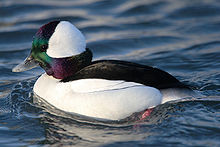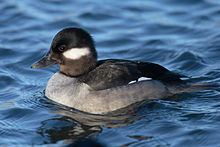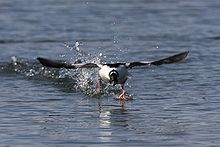- Bufflehead
-
Bufflehead 
male Conservation status Scientific classification Kingdom: Animalia Phylum: Chordata Class: Aves Order: Anseriformes Family: Anatidae Subfamily: Merginae Genus: Bucephala Species: B. albeola Binomial name Bucephala albeola
(Linnaeus, 1758)Synonyms Anas albeola Linnaeus, 1758
Charitonetta albeolaThe Bufflehead (Bucephala albeola) is a small American sea duck of the genus Bucephala, the goldeneyes. This species was first described by Linnaeus in his Systema naturae in 1758 as Anas albeola.[2]
Contents
Description
The Bufflehead ranges from 32–40 cm long (12.5–16 inches) and 270–550 g (0.6–1.2 lbs), with the drakes larger than the females. Averaging 35.5 cm (14 in) and 370 g (13 oz), it rivals the Green-winged Teal as the smallest American duck.
Adult males are striking black and white, with iridescent green and purple heads with a large white patch behind the eye. Females are grey-toned with a smaller white patch behind the eye and a light underside.[3]
The name Bufflehead is a combination of buffalo and head, referring to the oddly bulbous head shape of the species.[4] This is most noticeable when the male puffs out the feathers on the head, thus greatly increasing the apparent size of the head.
Distribution and habitat
They are migratory and most of them winter in protected coastal waters, or open inland waters, on the east and west coasts of North America and the southern United States. The Bufflehead is an extremely rare vagrant to western Europe. Their breeding habitat is wooded lakes and ponds in Alaska and Canada, almost entirely included in the boreal forest or taiga habitat.
Behavior
Buffleheads have evolved their small size in order to fit the nesting cavity of their "metabiotic" host, a woodpecker, the Northern Flicker.[5] Due to their small size, they are highly active, undertaking dives almost continuously sustained by their high metabolism. They do not tend to collect in large flocks; groups are usually limited to small numbers. One duck will serve as a sentry, watching for predators as the others in the group dive in search of food.[3] Buffleheads are amongst the last waterfowl to leave their breeding grounds and one of the world's most punctual migrants, arriving on their wintering grounds within a narrow margin of time.[6]
Breeding
Buffleheads are monogamous, and the females return to the same breeding site, year after year. They nest in cavities in trees, primarily aspens or poplars, using mostly old Flicker nests, close (usually <25 m) to water. Nest competitors include Mountain Bluebird (Sialia currucoides), Tree Swallow (Tachycineta bicolor), and European Starling. There was one recorded instance of a female Barrow's Goldeneye killing a Bufflehead adult female and her brood. Smaller cavities are preferred because of less competition with the larger Goldeneyes. Females may be killed on the nest by mammals, such as weasels (Mustela spp.) or mink (Mustela vison), and by Goldeneyes over nest competition.
Average clutch size is 9 (range 6–11), and eggs average 50.5 by 36.3 mm.[5] Incubation averages 30 days, and nest success is high (79% in one study) compared to ground-nesting species like the Teal. A day after the last duckling hatches the brood leaps from the nest cavity. The young fledge at 50–55 days of age.[7] Predators of adults include the Peregrine Falcon (Falco peregrinus), Snowy Owl (Bubo scandiacus), Bald Eagle (Haliaeetus leucocephalus), Great Horned Owl (Bubo virginianus), and Cooper's Hawk (Accipiter cooperii).
Diet
These diving birds forage underwater. They prefer water depths of 1.2–4.5 m (4 to 15 ft).[3] In freshwater habitats they eat primarily insects, and in saltwater they feed predominantly on crustaceans and mollusks. Aquatic plants and fish eggs can often become locally important food items as well.
Relationship with humans
Because of their striking plumage, highly active nature and their close proximity to humans on waterfront properties, Buffleheads are one of the most popular birds amongst bird watchers.[7] For these reasons and others, they are the first species of ducks to be boldly displayed on a Coat of Arms.[8] Buffleheads are still hunted for "sport" though they are too small and "gamey" to be considered a "gamebird". In contrast to many other seaducks that have declined in recent decades, Bufflehead numbers have remained relatively constant.[5] Habitat degradation is the major threat to this bird, since they depend on very limited coastal habitat on their wintering grounds, and very specific habitat in their boreal breeding grounds. Although Buffleheads do use man-made nest boxes, they still need the forest habitat to thrive.
References
- ^ BirdLife International. "Bucephala albeola". Archived from the original on 12 April 2008. http://web.archive.org/web/20080412094053/http://www.iucnredlist.org/search/details.php/47233/summ. Retrieved 20 July 2008.
- ^ Linnaeus, C (1758) (in Latin). Systema naturae per regna tria naturae, secundum classes, ordines, genera, species, cum characteribus, differentiis, synonymis, locis. Tomus I. Holmiae. (Laurentii Salvii). p. 124. "A. alba, dorso remigibusque nigris, capite caerulescente, occipite albo."
- ^ a b c Lippson, Alice Jane; Lippson, Robert L. (1997). Life in the Chesapeake Bay. JHU Press. pp. 253. ISBN 080185475X. http://books.google.com/books?id=SADdrFVym2cC&pg=PA253.
- ^ Fergus, Charles (2004). Wildlife of Virginia and Maryland and Washington DC. Stackpole Books. pp. 166. ISBN 0811728218. http://books.google.com/books?id=W7UxSPd2XMAC&pg=PA166.
- ^ a b c Gauthier, G. 1993. Bufflehead, Bucephala albeola. The Birds of North America. (67), 24 pages. Edited by A. Poole and F. Gill, The Academy of Natural Sciences of Philadelphia.
- ^ Finley, J.K. 2007. The punctual Bufflehead, Bucephala albeola: autumn arrivals in Shoal Harbour Sanctuary, Vancouver Island, in relation to freeze-up. Canadian Field-Naturalist 121:370-374.
- ^ a b Erskine, A. J. 1972. Buffleheads. Canadian Wildlife Service Monograph Series #4. Information Canada, Ottawa. 240 pages
- ^ Town of Sidney, British Columbia, web site
External links
Wikimedia Foundation. 2010.



